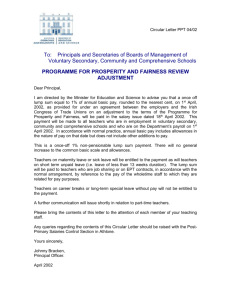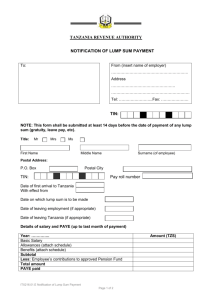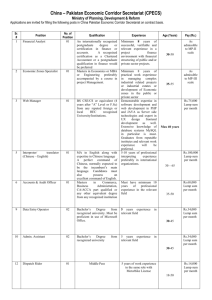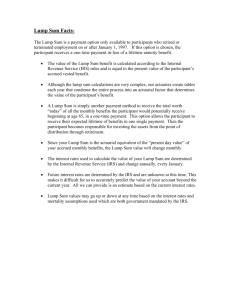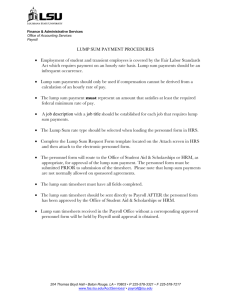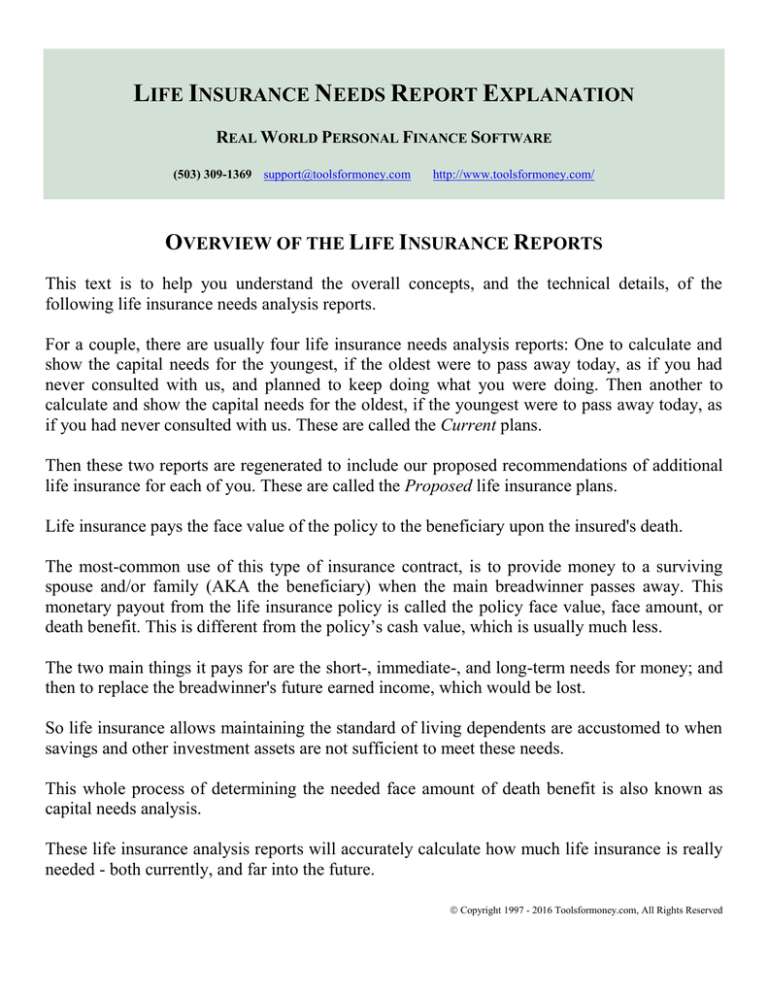
LIFE INSURANCE NEEDS REPORT EXPLANATION
REAL WORLD PERSONAL FINANCE SOFTWARE
(503) 309-1369 support@toolsformoney.com
http://www.toolsformoney.com/
OVERVIEW OF THE LIFE INSURANCE REPORTS
This text is to help you understand the overall concepts, and the technical details, of the
following life insurance needs analysis reports.
For a couple, there are usually four life insurance needs analysis reports: One to calculate and
show the capital needs for the youngest, if the oldest were to pass away today, as if you had
never consulted with us, and planned to keep doing what you were doing. Then another to
calculate and show the capital needs for the oldest, if the youngest were to pass away today, as
if you had never consulted with us. These are called the Current plans.
Then these two reports are regenerated to include our proposed recommendations of additional
life insurance for each of you. These are called the Proposed life insurance plans.
Life insurance pays the face value of the policy to the beneficiary upon the insured's death.
The most-common use of this type of insurance contract, is to provide money to a surviving
spouse and/or family (AKA the beneficiary) when the main breadwinner passes away. This
monetary payout from the life insurance policy is called the policy face value, face amount, or
death benefit. This is different from the policy’s cash value, which is usually much less.
The two main things it pays for are the short-, immediate-, and long-term needs for money; and
then to replace the breadwinner's future earned income, which would be lost.
So life insurance allows maintaining the standard of living dependents are accustomed to when
savings and other investment assets are not sufficient to meet these needs.
This whole process of determining the needed face amount of death benefit is also known as
capital needs analysis.
These life insurance analysis reports will accurately calculate how much life insurance is really
needed - both currently, and far into the future.
Copyright 1997 - 2016 Toolsformoney.com, All Rights Reserved
VUL stands for Variable Universal Life Insurance, which has been state of the art in whole (or
permanent) life insurance for over five decades. The variable part allows one to invest in things
like stock mutual funds (which are called subaccounts), and universal means that it's flexible in
many ways. Universal means you can easily tinker with the main features without having to
alter the policy in writing (e.g., face value, cash value, premiums, bells and whistles, etc.).
Term life insurance does not have a "savings account" associated with it, so here you are just
buying pure life insurance. The most efficient form of term was ART (Annually Renewable
Term), but life insurance companies rarely sell that anymore because it doesn't make them
enough profit. Now it's all called Level Term Insurance, which is much more expensive.
Other than rare circumstances, term life insurance is much more affordable to maintain than
whole life. Because of the basic life insurance company business model, the bottom line is that
you're just giving a quarter to a third of all premiums paid to the life company and receiving
little-to-nothing in return, when you buy any type, other than generic term life insurance.
REPORT INFORMATION EXPLAINED
The life insurance needs program calculates the differences between four present values: Lump
sum needs vs. assets available & future income needs vs. future incomes available. This is then
the grand total amount of life insurance needed now.
Present value means what something in the future is worth today. Lump sum means what a
series of future payments (or just one future payment) is worth today, in one payment of money.
As you can see on the report, the present value of everything you chose to insure for is listed
first. These are summed and displayed as Total Lump Sum Currently Needed.
Then financial assets you said were currently available to meet the above needs were listed and
summed up. This total displays as Total Lump Sum Currently Available.
The next line, Current Unmet Lump Sum Life Insurance Needs, shows the difference between
these two totals.
The next section, Lump Sum Needed Today to Replace John's Future Income(s), calculates and
displays the current lump sum of money needed today, to replace John’s future income(s) that
would be lost to the family if he were to pass away today.
This amount is added to the net lump sum amount needed from above, and displays the, Total
Additional Life Insurance Needed Today to Fund All Needs. This is how much additional life
insurance is needed today if the breadwinner were to pass away. This displays the difference
left over that needs to be funded by purchasing more level-term life insurance today.
Copyright 1997 - 2016 Toolsformoney.com, All Rights Reserved
It is normal for these numbers showing the net life insurance needs to be very large in the
Current version of your financial plan, just because it requires sophisticated insurance software
to accurately calculate these (future income replacement) amounts. So this is probably the first
time this was done correctly for you.
Currently, Mary needs $2,475,000 worth of life insurance death benefits, if John were to pass
away today. All assets diverted to meeting these needs would produce around $475,000. So
there is a current need for $2,000,000 more life insurance on John. Looking at it another way,
liquidating current financial assets will fund around 10% of current needs.
Currently, John needs $1,325,000 if Mary were to pass away today. All assets diverted to
meeting these needs would produce around $475,000. So there is a current need for $850,000
more life insurance on Mary. Liquidating current financial assets will fund around 19% of
current needs, as shown in the last line of report data.
But these funds only cover things that can be paid for today, in one way or another.
This above analysis report shows how much life insurance should be maintained today. But
what about next year, and beyond? Instead of running a new report annually, this capital needs
analysis software also has the unique feature of being able to estimate capital needs very far into
your future.
PROJECTING THE FUTURE
This ability to forecast into the future exposes a little-known top-secret about life insurance
needs - they decline substantially every year. Life insurance needs decline annually because of
three factors (assuming the breadwinner would have kept on winning bread until there was no
need for life insurance anymore).
First, every year the insured survives is one less year of earned income that needs to be replaced
with insurance capital. This is by far the largest factor.
Next, the amount of lump sum needs decline as debts are paid off, children get through college,
and other large funding needs dissipate.
Then last, and usually least least, financial assets available to meet needs usually increase
annually as saving vehicles are added to, and investment and retirement accounts (hopefully)
grow with stock market advances over time.
Adding these three factors accurately result in VERY LARGE DECLINES in the need for life
insurance as every year goes by.
Copyright 1997 - 2016 Toolsformoney.com, All Rights Reserved
This matters a lot, because it's very important to know exactly how much life insurance you
need. Not only is it important to not waste big money maintaining too much life insurance,
which is very expensive (and becomes much more expensive every year), but you also need to
know if you've been underestimating, and thus underfunding, your needs (which is much worse
than just overpaying annual premiums).
The only way to know exactly how much insurance to maintain, is to input all of the factors that
go into calculating how much you really need, and then using this unique insurance software to
control how these needs will probably change in the future.
Just ignorantly keeping the same face amount funded forever results in wasting hundreds to
thousands annually maintaining unneeded life insurance. For the typical family, the amount of
wasted money over a decade is usually enough to buy a nice car, so this is not a trivial matter.
These future annual needs are displayed on the following report pages. There is also a column
of numbers to show the annual percentage decline in capital needs.
MISCELLANEOUS
This report illustrates how values may change over time. Once you go over a year or so, most
all projections will be substantially different compared to what was input.
So it's important to run the numbers whenever something changes, or at least annually.
Hopefully, all of the charts and graphs will be self-explanatory. If not, then feel free to contact
us for more information.
A good measure of the benefit of financial planning and investment management is how your
net worth improved over what you would have realized if you never met us, and continued
doing what you were doing.
Copyright 1997 - 2016 Toolsformoney.com, All Rights Reserved

